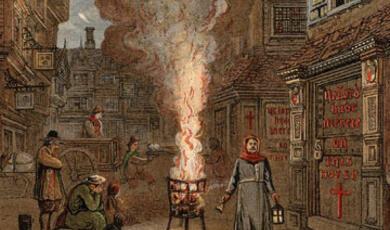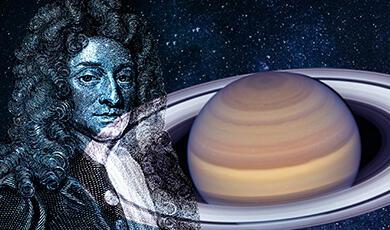Archimedes and the Mathematics of Spirals
Share
- Details
- Text
- Audio
- Downloads
- Extra Reading
This year’s tercentenary of the death of Gottfried Wilhelm Leibniz puts Leibniz in the limelight - which is deserving both because of his involvement in challenging aspects of mathematics as well as his friendly diplomacy towards other mathematicians. Dr Snezana Lawrence takes up the theme of spirals and the work of Archimedes.
This event was organised by Gresham College in partnership with the British Society for the History of Mathematics
Download Text
I am absolutely delighted to be able to start the evening dedicated to Leibniz. You may wonder how that is going to be possible as I will talk about spirals and Archimedes, but hopefully by the end of my talk that shall become more clear.
The talk’s title is slightly different to the one advertised – it now includes Archimedes, as his work on spirals is the ‘common thread’, to coin a phrase, that will be followed throughout my talk.
Leibniz
Leibniz, as we well know, has been celebrated this year, as it is his Tercentenary. Apart from his work on calculus, which was disputed by Newton and which for some time divided mathematical and scientific community, Leibniz was also a philosopher and theologian, most famously known in this field as propagator of an optimistic view of the universe: that what we have is the best possible world that God could have created.
In this slide we see a selection of his contributions: his theological writing as given in his book on Theodicy (1710)– i.e. why would a good God permit the manifestation of evil. His Stepped Reckoner, his Staffelwalze, invented between 1672 and 1694, was the first calculator that could perform all four arithmetic operations. Leibniz is not only important for actually making such a device, but has been credited by the invention of the binary system through his paper Explication de l'Arithmétique Binaire, presented in 1703 to the Académie Royale des Sciences in Paris.
Here is also an illustration from the Acta Eruditorum which was published in 1696 by Johann Bernoulli (brother of Jacob) about the problem of brachistochrone – a curve of shortest time, or fastest descent, which Leibniz, amongst other studied.
We won’t of course have the time to tackle all of these problems but will concentrate only on one – namely that relating to Archimedes and his famous spiral.
Archimedes
Apart from running out naked from his bath into a Syracusan street, exclaiming ‘Eureka, eureka’ (I have found it), he is also famous for the manner of his death. Yes, the Mediterranean crises are not rare or new. Archimedes died in around 212BC when Syracuse fell to the Romans. Reportedly, Archimedes was annoyed at the disruption of his flow of thought, and ordered a soldier to leave, being killed in response.
His tomb is not known, although it was also built in Syracuse, having supposedly a carved cylinder and an inscribed sphere at the entrance, to mark that this was the resting place of the great mathematician. Here’s an image of a tomb above Syracuse – perhaps this one is Archimedes’ tomb?
Archimedes is of course known not only for this and other mathematical discoveries, but for their practical applications. One of them was the ‘Claw of Archimedes’, reportedly used to lift the enemy ships out of the sea before crashing them back into the sea – Archimedes’ Law of the Lever comes to mind.
I will dedicate this talk to another Archimedes’ invention – his spiral.
This is the spiral of Archimedes, it is generated as follows:
If a straight line of which one extremity remains fixed be made to revolve at a uniform rate in a plane until it returns to the position from which it started, and if, at the same time as the straight line revolves, a point move at a uniform rate along the straight line, starting from the fixed extremity, the point will describe a spiral in the plane.
Archimedes, On Spirals (Heath, T. L., 1897. The Works of Archimedes, p151.).
Let us play a game – spirals are an inspirational topic! How many times have you caught yourself drawing spirals and curves while in a meeting or talking over the phone? And how many children have been inspired to learn a little bit of mathematics when they learnt that they could actually find out the precise descriptions of such amazing figures if they study mathematics a little more.
This is an image of an imagined spiral – how did David manage to win the battle with a much stronger, taller, and more powerful enemy? Well he knew a little bit about the spirals…
You can think of other spirals as they are described by various motions too.
The three famous problems of ancient mathematics
Now we will look how this fits with the three most famous problems of ancient mathematics. We know what they were:
How to double the cube,
How to square the circle, and
How to trisect an angle.
Doubling of the cube
The mystery related to the first problem somewhat ‘rubs’ over the others: the doubling the cube or the Delian problem (described in Plato’s Republic c380BC). The legend has it (and Eratosthenes, the third librarian of the great Alexandrian library and the inventor of the sieve named after him confirms) that the Delians were told that if they could double the altar cube, they would be able to get rid of the plague.
What this problem shows us is how closely the Greek mythology was to the Greek mathematics of the time… or so we are to believe.
The other two problems
The two other problems of ancient mathematics are the trisecting and angle and squaring the circle. They were shown, in the course of the development of mathematics and geometry, to be incredibly important. We can probably say that they have been the thread that connects the antiquity with modern mathematics. These problems were shown to be impossible by the methods of Euclidean geometry, only in the 19th century.
In 1837 it was shown that trisecting an angle is not possible via Euclidean constructions.
In 1882 it was also shown that squaring of the circle was impossible as a consequence of the Lindemann-Weiesrstrass theorem which shows/proves that Pi is transcendental number.
The three ways of solving (geometric) problems
The three problems also correspond (although not in a one-to-one correspondence) to the three possible ways of solving problems in geometry as perceived by the ancients.
There are, we say, three types of problems in geometry, the so called ‘plane’, ‘solid’, and ‘linear’ problems. Those that can be solved with straight line and circle are properly called ‘plane’ problems, for the lines by which such problems are solved have their origin in a plane. Those problems that are solved by the use of one or more sections of the cone are called ‘solid’ problems. For it is necessary in the construction to use surfaces of solid figures, that is to say, cones. There remain the third type, the so-called ‘linear’ problem. For the construction in these cases curves other than those already mentioned are required, curves having a more varied and forced origin and arising from more irregular surfaces and from complex motions.
This quote from Pappus of Alexandria (c290BC – c350BC) appeared in his work Mathematical Collection (shown here the 1589 translation into Latin by Commandino).
Also shown on this slide is the illustration of the problem 48 from the Rhind papyrus which deals with the squaring of the circle, written about 1650BC.
It is here that we will now look at how to connect the two: the problem of squaring of the circle, and the ways of solving mathematical problems by curves of complex motions (according to Pappus).
Hippocrates’ Luna
First, let us look at the ancient problem – the squaring of the circle one – and how it puzzled mathematicians for millennia. We know that some have come close to solving it. For example Hippocrates of Chios constructed a lune which is equal in the area to the triangle as shown here.
This same problem interested Leonardo and many other scientists and mathematicians – here is an excerpt from Leonardo’s Right-angle isosceles triangle and lune of Hippocrates from Atlantic Codex (Codex Atlanticus) by Leonardo da Vinci, folio 443 recto. Image credit goes to Veneranda Biblioteca Ambrosiana.
Hippias’ Quadratrix
But how does this problem (of squaring the circle) relate to the problem of curves which are made from ‘complex’ motions?
Hippias of Ellis (c460BC-c400BC) gave a possible solution. He invented this for trisecting the angle (although we will leave this aside this time because of the shortness of time) and it was used to square the circle.
This curve is created by motion – it is the locus of the intersection of the parallel MN to the half-side of the square (in which the circle is inscribed) and the radius OP which moves from OA to OB. Both movements are done with constant and equal rate. The curve that is described is called the Quadratrix.
Use the lune to construct a square equal to a ¼ of a circle
This curve, with some manipulation, can give the construction of the square which is equal to the ¼ of the circle with center O. Now why has this not been enough and satisfied mathematicians? Because the construction is not possible by Euclidean tools – even on this image for example, using Euclidean ‘digital’ tools, the point of intersection of the lune and any other line is approximate, not exact.
Let us get back to Archimedes and his spirals
The genius of Archimedes is in his connection between pure and rigorous mathematical method, and the application to practical problems.
In the example of the Archimedean spiral we will see how Pappus’ ‘third’ way of solving mathematical problems relates well to the squaring of the circle.
Archimedes spiral, as we have seen previously, is locus of points that is rotated around a circular and when it rotates each point has constant rate of growth out from the center.
Archimedes described this in his work On Spirals.
We know of it as we have a copy of the book sent to Dositehus:
On most of the theorems which I sent to Conon, and of which you ask me from time to time to send you the proofs, the demonstrations are already before you in the books brought to you be Heracleides; and some more are also contained in that which I now send you.
Let us look at this spiral again.
So Archimedes mentions Conon – who was he and why was he important?
Conon and the Coma Berenices
We have the story about Conon as a mathematician and astronomer who lived at the court of Ptolemy III. Ptolemy warred regularly with the Syrians, and on one occasion when he was at war and his wife did not hear of him, she prayed to gods asking that her husband be saved. In return she promised to cut her (presumably beautiful and bountiful) hair if he came back alive. The story of battle between Greeks and Syrians was also apparently the story of battle between vanity and love: the husband was spared and came back home live and kicking.
However, when then his wife cut her hair there was some turmoil at the court – the husband did not like it! Conon reportedly saved the day by saying that Berenices’ hair vanished into the sky and made a constellation which would forever celebrate the victory of Ptolemy (so vanity did win at the end).
It is not known whether Conon actually described this curves in the shape of Archimedes’ spiral, but that is the guess. Archimedes, in his treatise On Spirals mentions Conon as crucial in pointing him to or proving the properties of this spiral (image credit to astrosurf.com).
Archimedes spiral and squaring of the circle
Archimedes showed in very simple terms the proofs how to construct the area of the circle which is equal to a rectangular area (a triangle – ½ rectangle). He gives this in his book as follows:
I say then that the area bounded by the piral and the straight line which has returned to the position from which it started is a third part of the circle described with the fixed point as centre and with radius the length traversed by the point along the straight line during one revolution.
And, if a straight line touch the spiral at the extreme end of the spiral, and another straight line be drawn at right angles to the line which has revolved and resumed its position from the fixed extremity of it, so as to meet the tangent, I say that the straight line so drawn to meet it is equal to the circumference of the circle.
The spiral some time later
We are coming now fast forward in time. The spiral was of interest and was shown in art and architecture – one such example would be some classical and neo-classical decorations.
But beyond that, it was also studied and described further. It is called sometimes the ‘linear’ spiral. This is because the spacing between intersections along a ray that generates it from the origin remains constant.
Polar coordinate systems were developed over centuries – it is interesting that Gregoire de Saint-Vincent (in 1647) and Cavalieri (in 1635), who also contributed to the development of calculus for example, also wrote and described polar system.
The equation of Archimedes’ spiral is , r=aO in other words, the rate of change is linear (a).
The 17th century saw the birth of a spiral which relates to this, but where the rate of change differs. It was described as equiangular by Descartes (1638) and logarithmic or Spira Mirabilis by Jacob Bernoulli. Its polar equation is r=ae bO
The main difference between these two spirals is that Archimedean spiral has a beginning in the center, whilst the Logarithmic does not – it tends towards the center, never quite reaching it.
Jacob Bernoulli, the proponent of Leibniz’s calculus, liked this spiral so much he wanted it engraved on his stone. One of the great mysteries and mistakes from the history of mathematics at the same time: how could a wrong spiral show on his grave stone, considering he both studied it and was from a very mathematical family?
Back to Leibniz
Apart from the dispute with Newton, Leibniz has sometimes been accused for the lack of rigour in his work. This can be put to rest – both of the claims – as in 1993 the paper of his on Arithmetical quadrature of the circle, of the ellipse, and of the hyperbola, which he wrote in 1675-6 but was not published within his lifetime, shows his work in this area (for further reading, see Knobloch, E. 2012. Leibniz and the Infinite in Documenta Mathematica, 19-23.)
Here he explicitly refers to Archimedes and his work on the squaring of the circle problem:
Hence the method of indivisibles which finds the areas of spaces by means of sums of lines can be regarded as proven
And this is how the two were connected, and the spiral was a thread of connection between them.
Curves of life
And to finish the talk, I could have shown you any number of examples from nature depicting approximations to spirals – both Archimedean, and logarithmic. The latter is often shown as a link to how much of mathematics there is in everyday life, and I have chosen here to show you how this shows in our own bodies.
Here is an example of cochlea, part of our hearing apparatus (image credit to C. G. Wright, PhD. UT Southwestern Medical Center, Dallas, USA).
Thank you!
© Dr Snezana Lawrence, 2016
This event was on Thu, 27 Oct 2016
Support Gresham
Gresham College has offered an outstanding education to the public free of charge for over 400 years. Today, Gresham College plays an important role in fostering a love of learning and a greater understanding of ourselves and the world around us. Your donation will help to widen our reach and to broaden our audience, allowing more people to benefit from a high-quality education from some of the brightest minds.


 Login
Login







